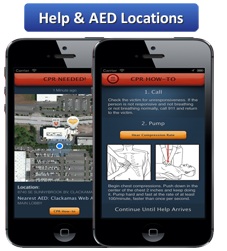
[cs_section id="" class=" " style="margin: 0px; padding: 45px 0px 0px; " visibility="" bg_image="" bg_color="" parallax="false"][cs_row id="" class=" " style="margin: 0px auto; padding: 0px; " visibility="" inner_container="true" marginless_columns="false" bg_color="" marginlesscolumns=""][cs_column id="" class="" style="padding: 0px; " bg_color="" fade="false" fade_animation="in" fade_animation_offset="45px" fade_duration="750" element_info="" type="1/1"][cs_text id="" class="" style="" text_align=""]
[/cs_text][cs_text id="" class="" style="" text_align=""]
Tech advances like online access and gamification are making CPR/AED training courses more accessible and effective, just in time.
New mobile apps are being used by local government emergency management groups to better connect the closest first responders to cardiac arrest victims. As someone trained in CPR, your chances of being called to assist a cardiac arrest in the field are growing.
For example, 911 dispatchers are using the PulsePoint Foundation’s “Respond” Mobile App to send a notification to nearby registered users when CPR or AED rescue is needed – stat!
A map appears on the responder’s mobile phone, pinpointing the victim’s location and how many responders are available.
“As of October 2015, more than 400,000 people trained and certified in CPR have installed the Respond app on their iPhone or Android devices,” according to an October 10, 2015 Huffington Post article. Richard Price, chief of the San Ramon, California, fire department and president of the PulsePoint Foundation, told The Huffington Post that “the PulsePoint Respond app has now activated almost 16,000 people trained in CPR to respond to more than 6,000 nearby cardiac emergencies.”
The technology has already spread, according to Price, into “1,400 cities and communities in 23 states.”
Technology tools used during training and after will be vital to your successful response in the field. You want to make sure your CPR vendor can offer the latest, most effective and certifiable technology support .
[/cs_text][x_custom_headline level="h2" looks_like="h3" accent="false"]A Checklist -- Make Sure Your CPR Trainer Offers These Advances[/x_custom_headline][cs_text id="" class="" style="" text_align=""]Online CPR Classes that meet AHA certification requirements (1). CPR classes meeting AHA certification requirements can now be delivered online or in a blended online/in person format as long as they are blended with in-person assessments. [/cs_text][cs_text id="" class="" style="" text_align=""]eLearning and Online programs for CPR certification are proliferating. Millions of Google reference links were returned with one quick search query for “CPR certification training”.
Online programs can even be designed to meet American Heart Association certification requirements.
Buyer beware! Many of them claim to prepare you for a certification using only online learning. This is a scam – first-time CPR students must have an in-person assessment, and pass that assessment in order to meet qualifications for certification.[/cs_text][/cs_column][/cs_row][/cs_section][cs_section id="" class=" " style="margin: 20px 0px 0px; padding: 0px; border-style: solid; border-width: px; border-color: #1e73be; " visibility="" bg_color="#e6ecf2" parallax="false"][cs_row id="" class=" " style="margin: 0px auto; padding: 0px 20px; " visibility="" inner_container="false" marginless_columns="false" bg_color=""][cs_column id="" class="" style="padding: 0px; " bg_color="" fade="false" fade_animation="in" fade_animation_offset="45px" fade_duration="750" type="1/1"][cs_text id="" class="" style="" text_align=""](1) “No AHA course completion card is issues without hands-on manikin skills testing by either an AHA Instructor for that discipline or an AHA-approved computerized manikin in an AHA eLearning course.” American Heart Association, Inc., Program Administration Manual, 2013, page 49.[/cs_text][/cs_column][/cs_row][/cs_section][cs_section id="" class=" " style="margin: 0px; padding: 45px 0px 15px; " visibility="" parallax="false"][cs_row id="" class=" " style="margin: 0px auto; padding: 0px; " visibility="" inner_container="true" marginless_columns="false" bg_color=""][cs_column id="" class="" style="padding: 0px; " bg_color="" fade="false" fade_animation="in" fade_animation_offset="45px" fade_duration="750" type="1/1"][cs_text id="" class="" style="" text_align=""]
[/cs_text][cs_text id="" class="" style="" text_align=""]Does your CPR trainer uses gamification software? Gamification is hitting the main stream in education. Kaplan tested gamification in their online course delivery and found it boosted grades by 9% with greater student engagement and fewer drop outs.
At least one study of high school students has shown that CPR training specifically is more effective when gamification is used. Students in the study also reported by more self-confident about responding effectively to a cardiac arrest. Beating Heart Center’s Loop Learning System is one example of how gamification can help learners succeed. [/cs_text][x_custom_headline level="h2" looks_like="h3" accent="false"] Post training mobile apps are helping responders maintain their edge[/x_custom_headline][cs_text id="" class="" style="" text_align=""]Studies also show that people with more recent CPR training are more likely to respond to an emergency (2). Basic skills can deteriorate quickly after training without refresher instructions. Mobile apps are now being deployed to help fill that gap.
The mobile app developed by the American Health And Safety Institute, for example, includes the following support assets:[/cs_text][cs_text id="" class="" style="" text_align=""]
[/cs_text][cs_text id="" class="" style="" text_align=""]Managing your certification is easier with app support as well. The AHSI mobile app (not sure which link you want to use – to your site or to AHSI? Please plug in which one you want) stores the learner’s certificate for quick and easy reference on the go. The app even uses the data to trigger email reminders to students when it’s time to get recertification.
As technology continues to aid health care responders, the Beating Heart Center is committed to bringing you the newest updates.
Follow us on Facebook or Twitter to keep up with the latest in CPR, AED and First Aid training. More information is available here about different CPR training modalities such as online, in person and blended CPR Classes in the San Diego area.[/cs_text][cs_text id="" class="" style="" text_align=""](2) 2010 “American Heart Association Guidelines for Cardiopulmonary Resuscitation and Emergency Cardiovascular Care.” Circulation 122 supp. 3 (2010); S921-923.[/cs_text][/cs_column][/cs_row][/cs_section][cs_section id="" class=" " style="margin: 0px; padding: 0px; border-style: solid; border-width: 2px; border-color: #1e73be; " visibility="" bg_color="#d5e0e8" parallax="false"][cs_row id="" class=" " style="margin: 0px auto; padding: 0px; " visibility="" inner_container="true" marginless_columns="false" bg_color=""][cs_column id="" class="" style="padding: 0px; " bg_color="" fade="false" fade_animation="in" fade_animation_offset="45px" fade_duration="750" type="1/1"][cs_text id="" class="" style="" text_align=""]
[/cs_text][/cs_column][/cs_row][/cs_section]